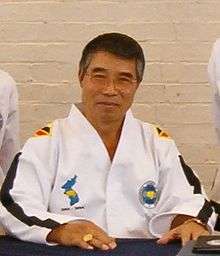Ki Ha Rhee
Rhee Ki Ha (born 20 March 1938) is a South Korean Grandmaster of Taekwon-Do who is widely recognised as the 'Father of British Taekwon-Do' for introducing this martial art to the United Kingdom since arriving in 1967,[1] as well as the 'Father of Irish Taekwon-Do.'[2] He is one of the twelve original masters of taekwondo of the Korea Taekwon-Do Association.[3][4][5] Following a career in the South Korean military, GM Rhee emigrated to the United Kingdom in 1967. He was a notable officer of the International Taekwon-Do Federation (ITF) during Choi Hong Hi's leadership.
| Rhee Ki Ha | |
|---|---|
 K. H. Rhee, 2004 | |
| Born | 20 March 1938 Seoul, Korea |
| Residence | Glasgow, United Kingdom |
| Style | Taekwon-Do |
| Rank | 9th dan Taekwon-Do (ITF) 4th dan in Judo 2nd dan in Karate |
| Notable students | Robert Howard |
Early life
Rhee was born on 20 March 1938 in Seoul, Korea,[6][7] during the period of Japanese occupation. He is the eldest of seven children of Rhee Yung Ei and Ahn Soon Rae.[6] Rhee's martial arts training began when he was around 7 or 8 years of age, learning judo from his father,[2] and he was the only one of his siblings to pursue the martial arts.[6] He later learned karate from one of his schoolteachers.[2]
When Rhee served in the South Korean military forces, he came into contact with Choi Hong Hi and learned taekwondo in the 35th Infantry Division.[2] Rhee was a key figure in the introduction of taekwondo across the world, contributing to demonstrations in many different countries.[4][8] He later taught taekwondo to the US 8th Army and, in 1964, travelled to Singapore, where he trained Royal Air Force (RAF) personnel at RAF Changi.[2] Through the late 1960s and 1970s, Rhee was a key member of the taekwondo demonstration teams that accompanied H. H. Choi around the world.[9]
United Kingdom
In 1967, some of his students in the RAF, who had returned to the United Kingdom, invited Rhee to travel there to teach.[2] He arrived at Heathrow Airport, London, on 2 July 1967, and was ranked 5th dan at the time.[6][7] Reportedly, Rhee only planned to stay for two years, but ended up settling there.[2] Rhee Ki Ha founded the United Kingdom Taekwon-Do Association (UKTA) in 1967,[10] the Republic of Ireland Taekwon-Do Association in 1972,[2] at which time he was ranked 5th dan,[11] and the All European Taekwon-Do Association in 1979.[2] He was promoted to the rank of 7th dan either by 1973[12] or in 1974,[6][7] according to different sources. Rhee attained the rank of 8th dan in 1981, and was the first person ever promoted to 9th dan by H. H. Choi on 1 July 1997 in Saint Petersburg, Russia, taking from that point onwards the honorific of "First" Grand Master Rhee (FGMR)[2][6] Rhee was also described by Choi as "the best ever student of Taekwon-Do."[2]
Rhee is currently Vice President of one of the three ITF organisations.[13] He is listed as the "Founder of Taekwon-Do in Great Britain and Ireland" in the Taekwondo Hall of Fame.[14] He is listed as a pioneer in Europe (1950s, 1960s, and 1970s) in Chang Keun Choi's list of taekwondo pioneers.[15]
Personal life
Rhee married Heather Morris, sister of the UKTA's official photographer, in 1969.[6] Their eldest son, Andrew Kang-Hae Rhee (born 1970), is an 8th dan Senior Master, Taekwon-Do instructor based in Sydney, Australia.[16][17][18]
See also
- List of taekwondo grandmasters
- Master Rhee
References
- Grand Master Rhee Ki Ha, 9th Dan Archived 15 September 2008 at the Wayback Machine Retrieved on 29 July 2007; link has expired, as at 25 January 2010. New version Archived 20 February 2010 at the Wayback Machine retrieved on 25 January 2010.
- Republic of Ireland Taekwon-Do Association: Grand Master Rhee Ki Ha, 9th degree black belt Retrieved on 30 January 2010.
- Choi, H. H. (1972): Taekwon-Do: The Korean art of self-defence. Mississauga: International Taekwon-Do Federation.
- Park, S. H. (1993): "About the author." In H. H. Choi: Taekwon-Do: The Korean art of self-defence, 3rd ed. (Vol. 1, pp. 241–274). Mississauga: International Taekwon-Do Federation.
- A tribute to the original masters Archived 2010-05-25 at the Wayback Machine (c. 2007). Retrieved on 13 June 2007; link has expired, as at 1 July 2011.
- Rhee, A. K.-H. (2011): First Grand Master Rhee Ki Ha Retrieved on 18 August 2011.
- Derby School of Taekwon-Do: Forty years of Taekwon-Do in the United Kingdom Archived 14 January 2013 at Archive.today Retrieved on 13 January 2010; link updated on 25 January 2012.
- Vitale, G. (2009): A history of Taekwon-Do demo's (sic) Archived 15 July 2011 at the Wayback Machine Totally Tae Kwon Do, 5:41–45.
- Cox, S. (c. 2004): The history of Taekwon-Do and its founder Archived 2009-04-04 at the Wayback Machine Retrieved on 3 February 2010.
- United Kingdom Taekwon-Do Association Scotland Archived 22 April 2010 at the Wayback Machine Retrieved on 30 January 2010.
- Irish National Tae Kwon-Do Association: Mr. Thomas Connor IV degree Archived 21 July 2011 at the Wayback Machine Retrieved on 30 January 2010.
- International Taekwon-Do Association Slovenia: ITF history Archived 2011-08-31 at the Wayback Machine Retrieved on 3 February 2010.
- ITF - GM Rhee's Message Retrieved on 3 October 2009.
- Taekwondo Hall of Fame Retrieved on 12 January 2008.
- Choi, C. K. (2007): Tae Kwon Do Pioneers Archived 2008-03-12 at the Wayback Machine Retrieved on 15 March 2008.
- United Kingdom Taekwon-Do Association: Other Masters Archived 21 December 2009 at the Wayback Machine Retrieved on 4 November 2009.
- Anonymous (2010): Training under the best Goulburn Post (8 January 2010). Retrieved on 30 January 2010.
- International Taekwon-Do Federation of Australasia: Master Andrew K. H. Rhee, VII Dan Archived 30 March 2012 at the Wayback Machine (2011). Retrieved on 18 August 2011.